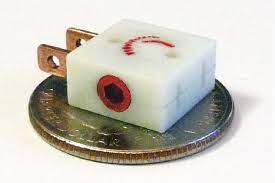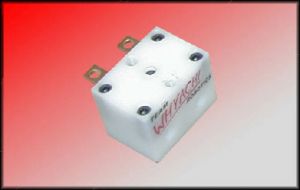Switches
To avoid injury, competition rules for combat robots in most cases require them to be turned off when entering or leaving the combat box or arena. Many also require a power indicating light so people can see if the bot is "live." Check the rules that govern your events before participating.
Design Considerations
- The switch must be direct-acting; it can't be a small switch that turns off a larger, inaccessible relay or contactor.
- Switches that maintain contact through moderate spring pressure may fail or momentarily open if your bot experiences high impacts. This is why maintaining positive contact with screws is so common.
- Normally switches need to be reachable from outside the bot, often with a tool. One thing designers need to consider is how to safely turn off the robot's power while it is active. Remember weapon and drive systems may not be working properly after a match, so place your switch making sure that both your tool (if any) and your hands are far away from moving parts. In larger robots, think about being able to access the switch without having to flip over the robot.
No Switch
If the rules allow it, some people will choose to power-on their robots by simply plugging in their batteries. This approach is only suitable for smaller robots, and often takes additional time with builders trying to secure the wires and closing covers on the bot before their match. It can also make it difficult to turn the robot off if it has sustained damage during the match. This approach can work on a non-weaponed bot but always use a dedicated power switch if your bot has a weapon.
Removable Link
In place of a switch, a removable link (loop of wire, jumper plug, or shorting bar) can be used. This link is pushed into a connector, which is placed where the link can be safely plucked from the robot without tools at the end of the match, or in case of emergency. These are common in UK/EU matches, as they are required by the FRA rules. Larger bots may require more than one link on opposite sides of the bot.
Power Switches
Most people choose some readily available power switches to turn their robots on and off. Although many options will work, some like Hella switches require significant modifications to be suitable for robot combat. Switches designed for robot combat all require some sort of tool to activate. This allows you to activate the switch without having to hold or manipulate your robot. This can be especially important after your match if your robot has taken damage.
Nano Power Combat Robotics Switch
This very simple switch uses a screw to contact conductive pads to complete the circuit. At <1g, it is suitable for tiny 150g robots and for 1lb robots that don't draw a lot of current.
Fingertech
This tiny 2.15g switch is extremely popular. It is well built, affordable, and can handle current up to 40 amps, making it suitable for many smaller to medium sized robots. It is activated by a 3/32" hex wrench.
Whyachi MS-05
The smaller switch from Team Whyachi weighs 1oz, making it much too big for insect sized robots, but it will easily handle 140 amps for a 3 minute match making it great for medium sized weapon systems and sometimes, full-sized robot drive systems. It is activated by a 7/64" hex wrench.
Whyachi MS-2
This big switch comes in at 5oz but can handle tremendous amounts of current and is suitable for most large weapon systems. One challenge with these switches is how then handle higher voltages. It takes several turns of the 5/32" hex wrench to make the connection, which can result in electrical arcing and damage to the contacts. There are some high-voltage add-ons which can reduce the problem.
Multiple Switches
The larger the bot, the more likely you will be required to meet strict safety rules regarding switch placement and accessibility. Your bot may need a separate weapons switch, mobility power switch, safety kill switch, and/or control circuits switch, so that only required circuits will be activated at any given time.
Power Lights
How do you know if your bot is powered on? Or more importantly, how does the crew running your event know if your bot is powered on? It is a best practice and a rule in many events events that a power-light indicator is easily visible. The presense of the light can also help troubleshoot some common mistakes such a failing to plug in the battery. As a best practice the power-light should be placed close to the power switch and be easily visible when turning the robot on or off. For small bots, the LEDs on the radio-receiver or control circuits can be made visible through the plastic body or through access holes meaning no seperate power-light is needed. When the internal lights are not visible, you will need to install one separatly. Many bots will have >1 switch due to the seperation of the drive and weapon systems. In these designs, it is important to have a power-light for each circuit.

